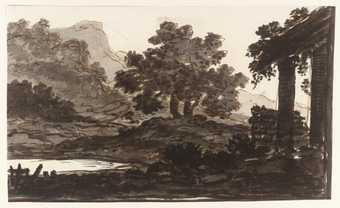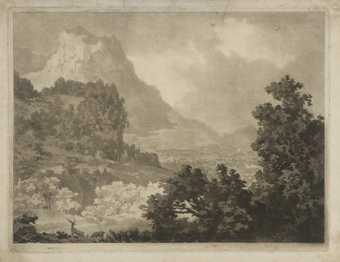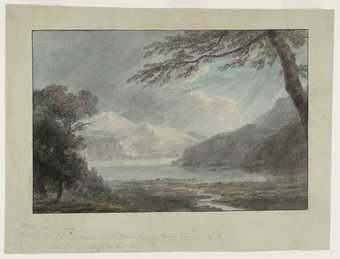
Alexander Cozens
Colonnade and Trees ()
Tate
During the greater part of the nineteenth century Alexander Cozens was known only as the father of his more celebrated son John Robert.
At the end of the century with a growing appreciation of the earlier English watercolor painters his work became known within a limited circle.
His English drawings were exhibited as a whole at the Burlington Fine Arts Club in 1916.
The book by Cozens which has the greatest interest for us is his New Method for Assisting the Invention in the Composition of Landscape which was published the year before he died.
In it he gives an account of the method of blotting which he had used in his own work and in teaching.
He had found in teaching that pupils spent too much time in copying details from prints or nature which distracted them from any idea of general composition that they had when they started. The way to avoid this occurred to him by chance when he found himself turning into a landscape an accidental stain on the paper that he was using. He then himself lightly stained a piece of paper and passed it to a pupil who converted it into a landscape.
The next step was to make the stain or blot in blacker ink and to use it as the basis for tracing by means of a frame or transparent varnished paper. In making the blot the mind must be directed firmly to the general idea or subject but the actual handling with a large brush must be performed as freely and rapidly as possible without attention to the details.
He advises that as many blots as possible should be made in quick succession, and, in order to make them even more accidental, the paper might be crumpled and then smoothed out.
When the blot has been made it should be covered with the tracing paper, the lighting be selected as such forms and masses as are suggested should be freely traced. Everything that is not wanted should be omitted but nothing added. Figures and animals should be outlined in pencil but everything else be traced with the brush. This tracing forms the second or ‘sketch’ stage; in the third a sky should be added, the forms worked up with light and shadow and the planes or ground determined to give aerial perspective or, as it was called, keeping.
Sixteen of the plates are examples of blots in their first state; three others show a blot with its two stages of completion and four more another blot with three finished drawings based upon it. The remaining five plates contain the 20 skies mentioned.
Examples of drawings made by Cozens and his pupils from these plates, and an original blot with its drawing by a pupil are included in the exhibition.


